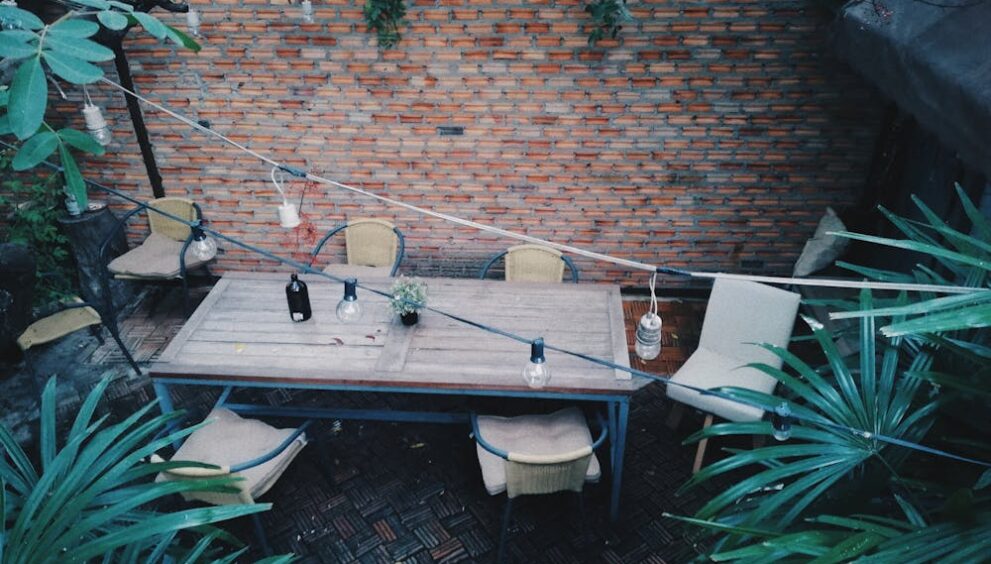Eco-Friendly Decorating: Sustainable Ideas for Your Small Backyard

Decorating a small backyard can feel like a challenge, especially when trying to balance aesthetics with eco-friendly choices. However, with thoughtful planning and sustainable ideas, you can transform even the smallest outdoor space into a beautiful and environmentally conscious oasis. By incorporating green practices and clever design tips, you can create a backyard that’s both functional and mindful of the planet.
So, let’s explore some eco-friendly ideas for turning your small backyard into a stylish, sustainable retreat.
Maximize Space with Vertical Gardens
In a small backyard, space is at a premium. One of the most efficient ways to add greenery while conserving space is by using vertical gardens. Vertical gardens allow you to grow plants on walls, trellises, or stacked containers, creating an eye-catching display without taking up precious ground space. This method not only enhances the visual appeal of your backyard but also promotes biodiversity by encouraging a variety of plants to thrive in a compact area.
You can use repurposed wood, recycled pallets, or biodegradable materials to create a vertical garden frame, keeping the eco-friendly theme intact. Planting native species and drought-resistant plants can further minimize your environmental footprint, as these plants typically require less water and maintenance.
Use Recycled and Repurposed Materials
One of the most impactful ways to decorate sustainably is by using recycled and repurposed materials. Instead of buying new outdoor furniture or décor, consider giving old items a new lease on life. Upcycling furniture, such as turning an old wooden bench into a garden seating area or converting unused pots into plant holders, reduces waste and adds a unique, personalized touch to your backyard.
Scour flea markets, garage sales, or online platforms for second-hand items that can be transformed into functional and stylish pieces for your outdoor space. Repurposing materials like metal, wood, or stone not only reduces the demand for new resources but also adds character and charm to your backyard.
Incorporate Solar Lighting for Energy Efficiency
When decorating your backyard, lighting plays a crucial role in setting the ambiance for evening relaxation or gatherings. Instead of relying on traditional electric lights, consider switching to solar-powered lighting options to reduce your energy consumption. This is where outdoor solar fairy lights become a game-changer.
Transform your garden with energy-efficient outdoor solar fairy lights, which provide a warm, magical glow without adding to your electricity bill. These lights are powered by sunlight, storing energy during the day and illuminating your backyard in the evening. Not only are they practical, but they also add a whimsical charm to your outdoor space while being kind to the environment.
When selecting solar lights, look for durable, weather-resistant options to ensure they last through various seasons. Strategically place them along pathways, around seating areas, or intertwined with plants to highlight the beauty of your garden at night. This small yet significant change can make a big difference in creating a sustainable backyard environment.
Opt for Sustainable Furniture
When choosing furniture for your small backyard, prioritize eco-friendly materials such as bamboo, reclaimed wood, or recycled plastic. These materials are not only durable but also sourced sustainably, making them excellent choices for environmentally conscious homeowners. Bamboo, for instance, is a fast-growing, renewable resource, while reclaimed wood adds a rustic, earthy feel to any outdoor setting.
Additionally, look for furniture made by companies that prioritize sustainable manufacturing practices. By supporting brands that care about the environment, you’re contributing to a more sustainable future while enjoying high-quality, long-lasting pieces.
Create a Composting Area
Another sustainable idea for your backyard is to set up a small composting station. Composting is an excellent way to reduce household waste by turning organic materials like food scraps and garden clippings into nutrient-rich fertilizer for your plants. Even in a small backyard, you can create a composting bin tucked into a corner or alongside your vertical garden.
By using compost in your garden, you’ll improve soil quality, reduce the need for chemical fertilizers, and enhance plant growth naturally. Plus, composting helps lower your carbon footprint by reducing the amount of waste sent to landfills.
Introduce Native Plants to Promote Biodiversity
Choosing the right plants for your small backyard is crucial for maintaining a sustainable environment. Native plants are an excellent choice as they are well-suited to the local climate, requiring less water, fertilizer, and overall maintenance. These plants support local wildlife, such as pollinators like bees and butterflies, which are essential for biodiversity.
Additionally, native plants tend to be more resilient against pests and diseases, reducing the need for chemical treatments that can harm the environment. Whether you’re planting flowers, shrubs, or trees, opting for native species is a simple way to make your garden eco-friendlier.
Install a Rainwater Collection System
Water is a precious resource, and finding ways to conserve it should be a priority when decorating your backyard. Installing a rainwater collection system allows you to harvest rainwater, which can then be used to water your plants or clean outdoor surfaces. This not only reduces your reliance on tap water but also helps cut down on your water bills.
Even in a small backyard, a compact rain barrel can be discreetly placed under a downspout to collect runoff during rainy seasons. You can use the stored water to maintain your garden without adding strain on local water supplies, especially during dry spells.
Build a Wildlife Habitat
Sustainability in your backyard can also extend to supporting local wildlife. Building a small habitat for birds, insects, and other creatures encourages biodiversity and helps maintain a balanced ecosystem. Simple additions like birdhouses, insect hotels, and small water features can make a huge difference in attracting beneficial wildlife to your backyard.
By creating a space where nature can thrive, you’re contributing to the well-being of your local environment and enjoying the added beauty and life that these creatures bring to your outdoor space.
Conclusion
Creating a sustainable, eco-friendly backyard is all about making mindful choices that benefit both your outdoor space and the planet. With these simple tips, you can transform your backyard into a green oasis, reducing your carbon footprint and enjoying a beautiful space that reflects your commitment to sustainability.

 English
English 



